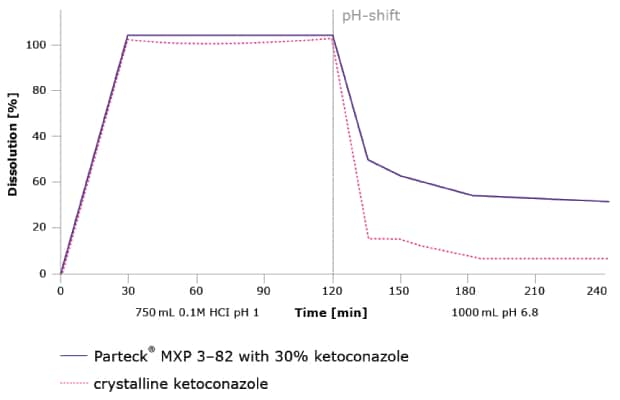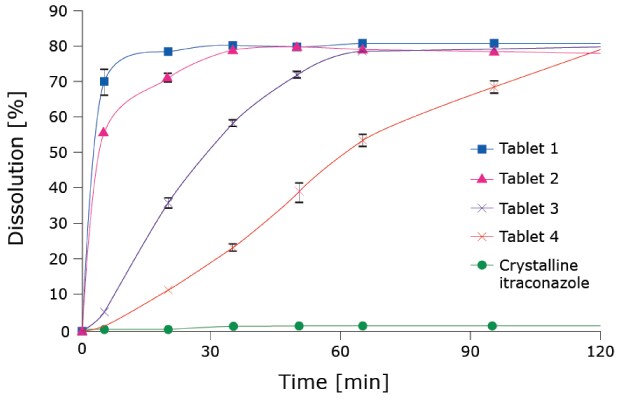Improving API Solubility Using Hot Melt Extrusion Formulation With Polyvinyl Alcohol
Poor solubility of active pharmaceutical ingredients (APIs) is a critical challenge in drug development. There are many avenues to improving API solubility including promoting API dissolution API processing, and formulation approaches. One formulation technique to increase solubility and, consequently, improve bioavailability of drugs is Hot Melt Extrusion (HME).
Section Overview
- What is Hot Melt Extrusion?
- What are the Advantages of Hot Melt Extrusion?
- What Polymers Can be Used in Hot Melt Extrusion?
- Polyvinyl Alcohol (PVA) as a HME Polymer
- Impact of PVA on Supersaturation Stability and Absorption
- PVA Formulation Flexibility: Final Dosage Form
- PVA Formulation Flexibility: Release Kinetics
- Conclusion
What is Hot Melt Extrusion?
During Hot Melt Extrusion, the API is dispersed, often down to the molecular level, into a polymer matrix to form an amorphous solid dispersion (Figure 1). It is a solvent-free process that is applicable to a broad range of poorly soluble APIs, making it suitable for various solid dosage formulations.
In this article, we’ll discuss the basics of Hot Melt Extrusion and how it can be used for enhancing API solubility, and share solubility data based on our PVA-based Parteck® MXP excipients (Parteck® MXP 4-88 and Parteck® MXP 3-82) which are developed for HME.

Figure 1.The API is melted and mixed with a matrix polymer in the extruder to enable homogeneous dispersion of the API within the polymer.
When developing an HME formulation, the suitability of the API and polymer for the process must be considered. Characteristics such as polymer degradation temperatures are often limiting factors. Good thermoplasticity of the polymer, stabilization of the API, and precipitation inhibition are also prerequisites for HME. A high solubilization capacity of the polymer with respect to the API is also desirable, as this allows for high drug loadings. Recent work has expanded upon analytical and in silico tools to assess the compatibility of drugs with polymers which can also be applied to the HME formulation.1,2
What are the Advantages of Hot Melt Extrusion?
Advantages of HME include enhanced solubility and bioavailability of the API; flexibility in drug release kinetics allowing for both immediate and sustained release; good scalability; and compatibility with continuous manufacturing. HME also provides great versatility; potential downstream options include direct shaping of the extrudate into tablets or other downstream processing of the extrudate such as pelletizing, milling, and direct tablet compression. In contrast to other solid dispersion technologies, HME is a solvent-free process.
What Polymers Can be Used in Hot Melt Extrusion?
Various polymers can be used in HME processes including cellulose derivatives, polyacrylates and polymethacrylates, polyethylene glycols, and polyvinyl pyrrolidone (PVP). Recently, polyvinyl alcohol (PVA) has been highlighted as a polymer particularly well-suited for HME.3
Polyvinyl Alcohol (PVA) as a HME Polymer
PVA is a synthetic polymer produced by polymerization of vinyl acetate and partial hydrolysis of the resulting ester-based polymer. First discovered in 1924,4 PVA has been used in approved drug products for decades5 and is generally recognized as safe by the US Food and Drug Administration (FDA).6 Furthermore, there is a body of scientific literature on the suitability of PVA for oral ingestion. The acceptable daily intake (ADI) for humans is 50 mg/kg of body weight as identified by the Joint FAO/WHO Expert Committee on Food Additives (JECFA) in 2003.7 To summarize, there is well-founded scientific evidence for the safety of PVA.8
PVA is a thermoplastic polymer, which shows a pseudo-plastic viscosity behavior; with an increased shear rate, the viscosity drops slightly which benefits the HME process. The higher the shear forces, the easier the extrusion – including high throughput rates, improved downstream processing, optimized melt flow through the channels and extended process ranges. By adding plasticizers, the application range of HME using PVA as carrier polymer can be extended to APIs with high and low melting temperatures.
The PVA-based Parteck® MXP excipients are specifically developed for use in HME. Their flowability allows for constant feed into the extruder which prevents negative impacts on reproducibility and continuous manufacturing processes. PVA-based polymers are suitable for a wide range of different APIs with different melting temperatures and APIs with high and stable drug loads (Table 1). They also enable a simple formulation design involving the excipient, API, and, if needed, plasticizer for extrusion.
As there is no one-size-fits-all approach in formulation, we created two Parteck® MXP polymer grades. A lower degree of hydrolysis polyvinyl alcohol grade (Parteck® MXP 3-82) forms stronger interactions with hydrophobic molecules and acts as a precipitation inhibitor, while a higher degree of hydrolysis polyvinyl alcohol grade (Parteck®MXP 4-88) has a very broad application range, including APIs that are typically not considered for HME due to their high melting points. Table 2 summarizes the key properties of the Parteck® MXP polymers.
Impact of PVA on Supersaturation Stability and Absorption
A common issue with solid dispersions is that the initially high level of dissolved API drops quickly. The solution is “supersaturated” in that there is more solute than the solubility allows in that environment. Recrystallization of the API occurs, sometimes promoted by certain conditions (e.g., pH-shift from the acidic stomach to the more neutral intestines).
The combination of complimentary API interactions with surface activity makes PVA an optimal inhibitor to prevent the precipitation of supersaturated API upon dissolution. In our study, PVA prolonged the supersaturated state of the poorly soluble weak base ketoconazole after a pH shift from a gastric to an intestinal environment. Compared to the crystalline itraconazole, we found that HME with Parteck® MXP polyvinyl alcohol improves dissolution percentage for at least two hours after a pH shift (Figure 2).

Figure 2.Dissolution profile of ketoconazole hot-melt extruded with Parteck® MXP excipient in comparison to the crystalline substance.
However, the importance of precipitation inhibition extends beyond weak bases and is an essential consideration when developing solubility-enhancing formulations of BCS class II compounds. Without effective precipitation inhibition after dissolution, the concentrations of API in solution will significantly decrease, resulting in a lower-than-expected bioavailability. Long-term and accelerated studies confirmed that the amorphous solid dispersion with Parteck® MXP and a high drug load of 30% is stable over time and without recrystallization during storage, maintaining its good dissolution performance. The precipitation inhibition effect of Parteck® MXP polymer supports a high and stable supersaturation state.
PVA Formulation Flexibility: Final Dosage Form
Parteck® MXP excipient can be used in a range of downstream processes to formulate a variety of final dosage forms. PVA extrudates can be:
- milled and compressed into tablets
- milled or pelletized and filled into capsules, or
- processed into direct-shaped tablets using injection molding.
Film extrusion and strand production for pelletization is also possible.
PVA Formulation Flexibility: Release Kinetics
Parteck® MXP excipient is versatile for use in HME as it can be used in both sustained-release and immediate-release formulations. For example, an itraconazole/Parteck® MXP 4-88 (30%/70%) extrudate was further processed to yield several different oral formulations: capsules (extrudate was pelletized prior to filling), directly compressed tablets (extrudate was milled prior to blending with further excipients and compressed), and direct-shaped tablets.
Pelletized extrudate filled into capsules helps to accelerate progress from preclinical to clinical testing for immediate-release formulations. In addition, the ability to use different size pellets creates greater flexibility when fine-tuning release kinetics based on the surface area of the pellet.
In the case of directly compressed tablets formulated using milled extrudate (Figure 3, Table 3), both immediate and sustained release profiles were achievable with Parteck® MXP 4-88 PVA depending on the other excipients added to the formulation.

Figure 3.Dosage forms with different release profiles (immediate and sustained) were successfully produced for tablet formulations.
Dissolution method: FDA-recommended conditions for itraconazole, 900 mL SGF 37°C, 100 rpm, formulated extrudate with 30% drug load; n=3
Varying the amount of extrudate and adding inorganic salts enables modification of release kinetics, due to the different dissolution kinetics of the PVA polymer in the presence of NaCl vs. K2CO3, with the slower dissolution in the latter also resulting in a slower dissolution of the API.
Direct-shaped tablets demonstrated sustained release kinetics (Figure 4), due to the substantially larger surface area of the dosage form, which allows PVA to gel in contact with water, slowing the release from the tablet. In addition, no significant changes in the release profile occurred upon the addition of 10 – 40% ethanol, an FDA requirement for sustained-release formulations.

Figure 4.Direct-shaped tablets with a sustained release profile were successfully produced with Parteck® MXP polyvinyl alcohol and showed no dose-dumping behavior with various concentrations of ethanol.
Dissolution method: FDA-recommended conditions for itraconazole, 900 mL of medium 37°C, 100 rpm, 200 mg itraconazole; n=6
Conclusion
Pharmaceutical HME has gained prominence in the pharmaceutical sector in recent years as one of the amorphous formulation technologies of choice due to benefits associated with high and stable drug loads; dosage form flexibility; solvent-free processing and compatibility with the important area of continuous pharmaceutical manufacturing. However, there is still a limited portfolio of polymers available which can be used for HME, as specific characteristics of the polymeric carrier material are mandatory such as thermal stability. At the same time, the number of poorly soluble APIs which would benefit from HME is continuously increasing. For this reason, researchers are constantly exploring options to enlarge their toolbox of HME suitable excipients. Polyvinyl alcohol is an established pharmaceutical excipient with a broad application range in HME as it can be used with APIs of different properties and in many different final dosage forms with different release kinetics requirements.
Need expert guidance? Reach out to our specialists to explore formulation solutions.
Related Products
References
如要继续阅读,请登录或创建帐户。
暂无帐户?